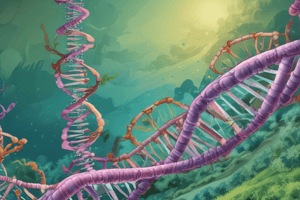Podcast
Questions and Answers
In recombinant DNA technology, what role do restriction enzymes play?
In recombinant DNA technology, what role do restriction enzymes play?
- Cutting the bacterial plasmid to create an opening for the new gene. (correct)
- Introducing the recombinant DNA into bacterial cells.
- Amplifying the number of copies of the gene of interest.
- Joining the gene of interest into the bacterial plasmid.
Which of the following is NOT a typical characteristic of organisms well-suited for recombinant DNA technology?
Which of the following is NOT a typical characteristic of organisms well-suited for recombinant DNA technology?
- Small physical size.
- Large space requirements. (correct)
- Ease of growth.
- Rapid multiplication.
After a recombinant DNA (rDNA) is created and introduced into a bacterial cell, what process ensures that the rDNA is passed on to future generations of bacteria?
After a recombinant DNA (rDNA) is created and introduced into a bacterial cell, what process ensures that the rDNA is passed on to future generations of bacteria?
- The cloning process of the bacteria. (correct)
- The process of gene mapping.
- Meiosis during bacterial reproduction.
- The bacteria accepting the rDNA.
What is the primary purpose of using vectors in genetic engineering?
What is the primary purpose of using vectors in genetic engineering?
In the production of human insulin using recombinant DNA technology, which step comes after the recombinant bacteria begins producing human insulin?
In the production of human insulin using recombinant DNA technology, which step comes after the recombinant bacteria begins producing human insulin?
Classical breeding is described as the traditional way of genetic engineering. What is its fundamental process?
Classical breeding is described as the traditional way of genetic engineering. What is its fundamental process?
Which of the following methods is used to physically insert recombinant DNA into a cell?
Which of the following methods is used to physically insert recombinant DNA into a cell?
A scientist aims to enhance a specific trait in a plant by increasing the expression of a desired gene. Which approach aligns with this objective?
A scientist aims to enhance a specific trait in a plant by increasing the expression of a desired gene. Which approach aligns with this objective?
Flashcards
Genetic Engineering Steps
Genetic Engineering Steps
A series of methods used to alter genetic material in organisms, including gene isolation, insertion, and expression.
Recombinant DNA Technology
Recombinant DNA Technology
A technology that involves combining DNA from different sources to produce desired traits or products.
Importance of Recombinant DNA
Importance of Recombinant DNA
Critical for producing insulin, vaccines, and genetically modified organisms (GMOs) for improved traits or disease resistance.
Human Insulin Production
Human Insulin Production
Signup and view all the flashcards
Vectors in Genetic Engineering
Vectors in Genetic Engineering
Signup and view all the flashcards
Microinjection
Microinjection
Signup and view all the flashcards
CRISPR
CRISPR
Signup and view all the flashcards
Restriction Enzymes
Restriction Enzymes
Signup and view all the flashcards
Study Notes
Genetic Engineering Overview
- Genetic engineering is the modification of an organism's genes/traits using biotechnology methods.
- Recombinant DNA technology, a modern genetic engineering technique, joins DNA molecules from different species.
- Modification of traits can involve introducing new traits, enhancing existing ones by increasing gene expression, or enhancing traits by disrupting gene expression.
- Vectors, like plasmids, act as vehicles to transfer rDNA into an organism.
- Other methods for introducing rDNA include microinjection, biolistics, electroporation, and heat shock treatment.
Steps in Genetic Engineering
- Cutting/Cleavage of DNA: Restriction enzymes, also known as nucleases, act as molecular scissors to cut DNA at specific sites.
- Selection of Appropriate Vector: Plasmids are commonly used vectors to transfer the DNA in the cells.
- Ligation: Joining the gene of interest with the vector to create recombinant DNA.
- Transfer of Recombinant DNA: Recombinant DNA is introduced into a host cell, often a bacterium.
- Selection Process: Identifying the cells containing the introduced gene.
- Sequencing: Identifying the gene or protein.
Production of Insulin using Genetic Engineering
- Humans produce insulin, a hormone that regulates blood sugar levels in the pancreas.
- Type 1 Diabetes occurs when the pancreas fails to produce sufficient insulin.
- Bacteria are a suitable host for insulin production due to their rapid growth and ease of manipulation.
- A human insulin gene is introduced into a plasmid (a loop of bacterial DNA).
- This creates recombinant DNA.
- The rDNA is introduced into the bacteria.
- Bacteria will produce human insulin.
- The insulin is harvested from the bacteria and purified for human use.
Studying That Suits You
Use AI to generate personalized quizzes and flashcards to suit your learning preferences.
Related Documents
Description
Explore genetic engineering techniques, including recombinant DNA technology. Learn how genes and traits of an organism are modified using processes like vectors, plasmids, microinjection, and electroporation. Discover the role of restriction enzymes.





